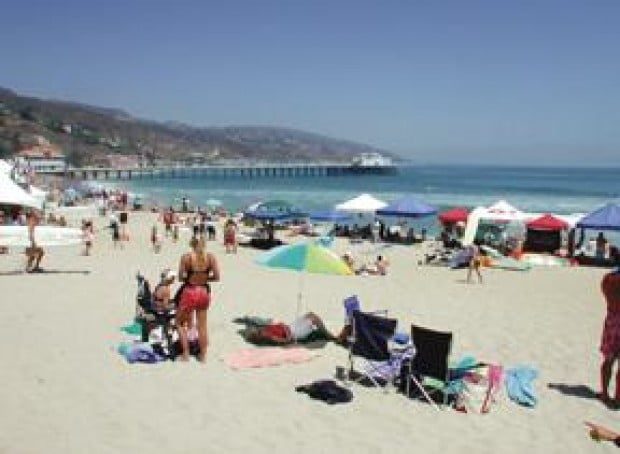
Every beach from Ventura County line south to Palos Verdes is mandated to meet state beach bacteria health standards 100 percent of the time or face penalties.
By Melonie Magruder / Special to The Malibu Times
Malibu is on the “Beach Bummer” list once again with one of the most famous beaches in the world listed as No. 5 in Heal the Bay’s list of California’s top 10 most polluted beaches-Surfrider Beach. This is the sixth time out of the past seven years the beach has made the list. The ocean water where the Marie Canyon storm drain empties takes the No. 3 slot. Marie Canyon is adjacent to Malibu Colony.
Heal the Bay, the local environmental watchdog that keeps the public informed of water quality concerns, released its 17th Annual Report Card for California beaches last week. And although the report card mostly points out trouble spots, there is some good news along with the bad.
The good news is some state beaches have seen improvement, earning them an “A” grading. The bad news is that six Los Angeles County beaches top the list of “Beach Bummers,” or those reflecting the worst water quality, including the two Malibu beaches and the beach at Santa Monica Pier.
Statewide, the water quality is above average due to the extremely dry weather conditions of the last year. Mike Grimmer, spokesman for Heal the Bay, said this is a natural result of drought circumstances. “If it’s not raining, it’s not flushing contaminants down into the storm drains which lead to the ocean,” he said.
Malibu, however, seems to continue to bear a disproportionate burden of polluted beaches, largely because of the city’s residential and commercial reliance on aging septic systems.
The pollution of Surfrider mainly comes from the Malibu Creek watershed, said Mark Gold, president of Heal the Bay. Even with the record drought, breaching of the creek’s berm has dumped polluted water into the ocean throughout the year. “It’s very well known among readers and surfers that when the sand berm is up, water quality is good,” Gold said, “and when it’s breached, it’s bad.”
The 110-square-mile watershed is polluted from upstream city runoff, including from vineyards and horse corrals, and from leaking septic systems, Gold said. “It all flows into the creek system” and that results in the high bacteria count, he said. He went on to say that the stormwater treatment facility at the Civic Center only treats runoff from that area-but does nothing for the upper watershed area.
Gold said the pollution at Marie Canyon is caused largely by over irrigation in the subwatershed of that area, causing a “chronic pollution problem.” He said the county is building a new treatment facility there that should alleviate the problem.
When AB 411 went into effect in 1999, every beach from Ventura County line south to Palos Verdes was mandated to meet state beach bacteria health standards 100 percent of the time by the summer of 2006 or face penalties. That compliance deadline passed, though, with many Santa Monica Bay beaches, including Ramirez Creek, Escondido Creek and Surfrider Beach still seeing bacteria levels exceeding TMDLs, or total maximum daily loads, which are the measure of allowable daily pollution limits in the water at any one site.
Last year, enforcement language was inserted into the Los Angeles County Storm Water Permit so the Regional Water Quality Control Board could start the process of enforcing the TMDLs through fines levied on cities where the infractions occur. “This summer will be a bell weather for the cities subject to enforcement,” Grimmer said.
Cities that are found to be in violation of the TMDLs could be fined up to $10,000 per day, per site. “We send out … letters to non-compliant cities, who must then begin sourcing studies to find out where the pollution is coming from,” said Steve Cain, spokesman for the L.A. County RWQCB.
Fran Diamond, chair of the LACWQC board, explained further, “This is the first step of enforcement action. What are the sources of the pollution? It is incumbent on the cities to find that source and then they can begin clean up. They have deadlines, but they have some months to pinpoint sources of contamination.”
Cain and Diamond both cited the Clean Beaches Initiative, a state grant project that began in 2001, which supplied L.A. County beach cities with nearly $133 million to create storm water diversions. “This will divert polluted storm water to treatment centers before it hits the ocean,” Cain said. “It is effective treatment, but it takes time to build these facilities.”
“The cities know that we are serious about compliance,” Diamond said. “Marie Canyon has a lot of septics. But the sewage treatment plant in Malibu will help and as people gradually update residential septic systems, it should yield cleaner beaches. But it does take time.” Incremental improvements seem to be the path forward.
“The Santa Monica Mountains have a lot of watersheds to the ocean,” Grimmer said. “Chautauqua Canyon raised their rating to a ‘B’ after installing diversions to manage their water run-off. The cities are starting to do something… slowly.”
2006-2007 Annual Beach Report Card California Beach Bummers
RANK BEACH COUNTY
1 Long Beach Los Angeles
2 Castlerock Storm Drain at Castle Rock Beach Los Angeles
3 Marie Canyon Storm Drain in Malibu Los Angeles
4 Avalon Beach on Catalina Island Los Angeles
5 Surfrider Beach in Malibu Los Angeles
6 Santa Monica Pier Los Angeles
7 Campbell Cove State Park Beach Sonoma
8 Venice Beach at Frenchman’s Creek San Mateo
9 Arroyo Burro Beach Santa Barbara
10 Cabrillo Beach, harborside at the
lifeguard tower Los Angeles
